Abstract
To determine whether beta-adrenergic receptor agonist activation influences guanosine 5'-triphosphate-binding protein (G-protein) expression and beta-adrenergic receptor kinase activity in the heart, we examined the effects of chronic beta 1-adrenergic receptor antagonist treatment (bisoprolol, 0.2 mg/kg per d i.v., 35 d) on components of the myocardial beta-adrenergic receptor-G-protein-adenylyl cyclase pathway in porcine myocardium. Three novel alterations in cardiac adrenergic signaling associated with chronic reduction in beta-adrenergic receptor agonist activation were found. First, there was coordinate downregulation of Gi alpha 2 and Gs alpha mRNA and protein expression in the left ventricle; reduced G-protein content was also found in the right atrium. Second, in the left ventricle, there was a twofold increase in beta-adrenergic receptor-dependent stimulation of adenylyl cyclase and a persistent high affinity state of the beta-adrenergic receptor. Finally, there was a reduction in left ventricular beta-adrenergic receptor kinase activity, suggesting a previously unrecognized association between the degree of adrenergic activation and myocardial beta-adrenergic receptor kinase expression. The heart appears to adapt in response to chronic beta-adrenergic receptor antagonist administration in a manner that would be expected to offset reduced agonist stimulation. The mechanisms for achieving this extend beyond beta-adrenergic receptor upregulation and include alterations in G-protein expression, beta-adrenergic receptor-Gs interaction, and myocardial beta-adrenergic receptor kinase activity.
Full text
PDF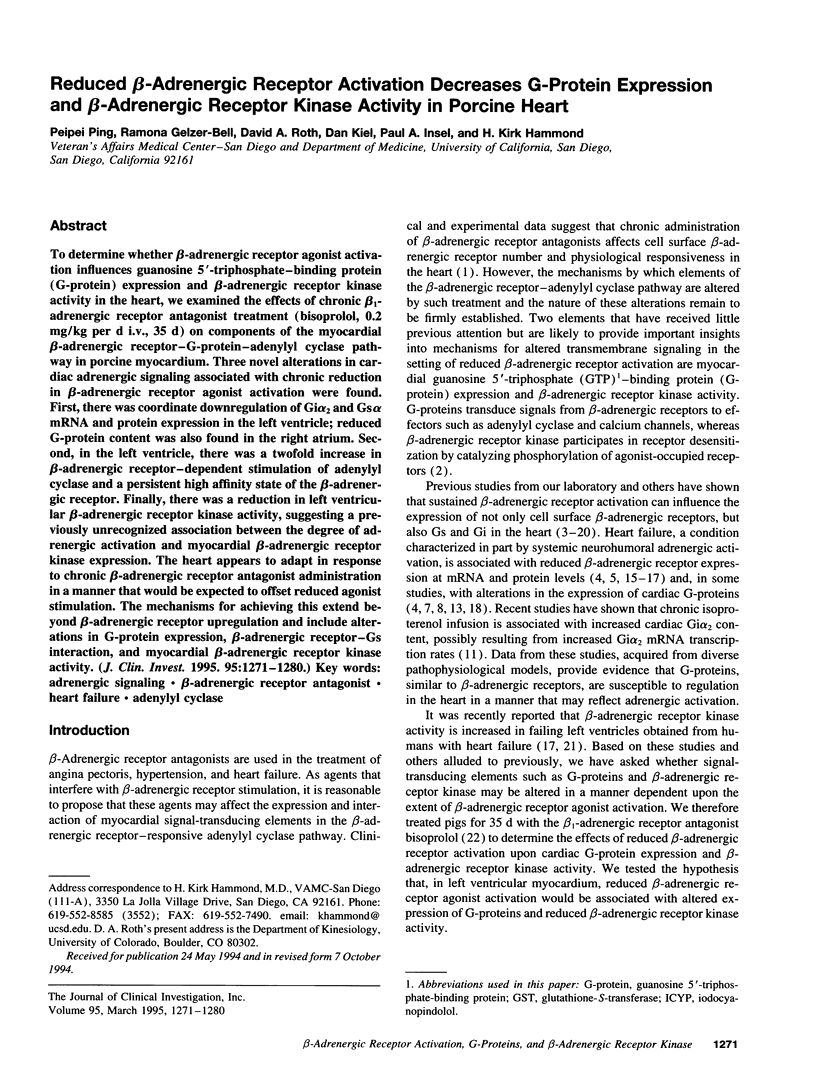
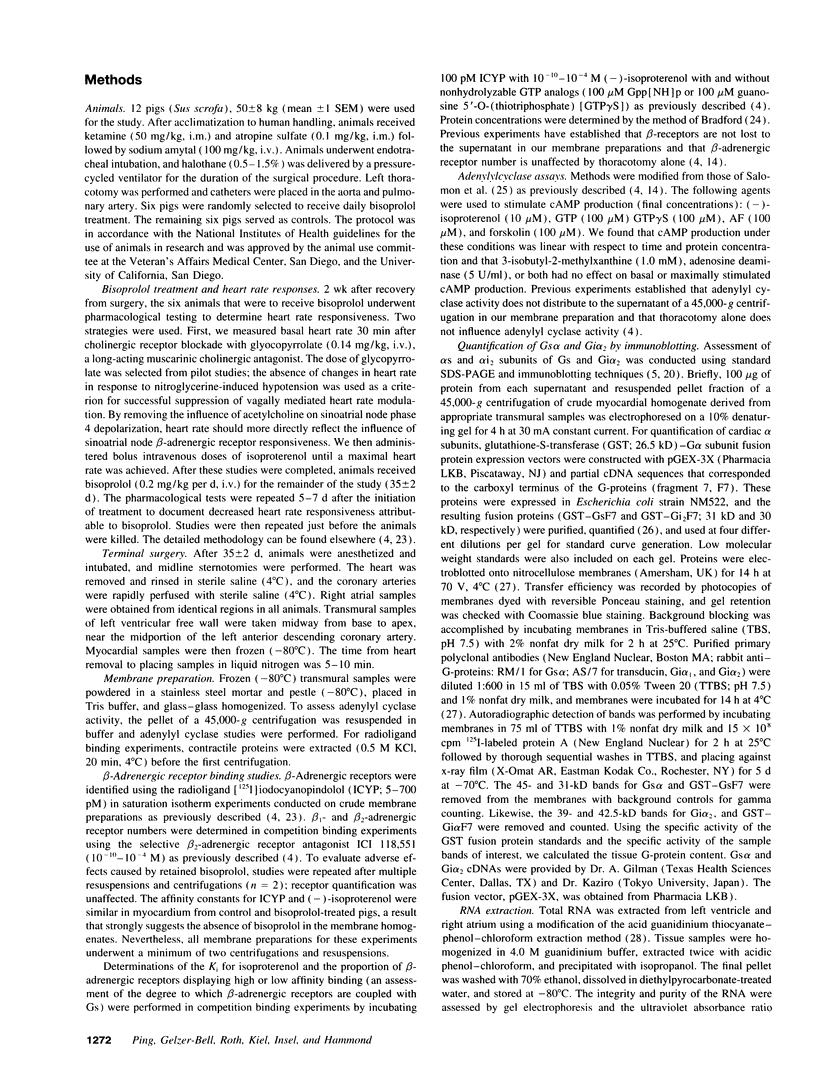
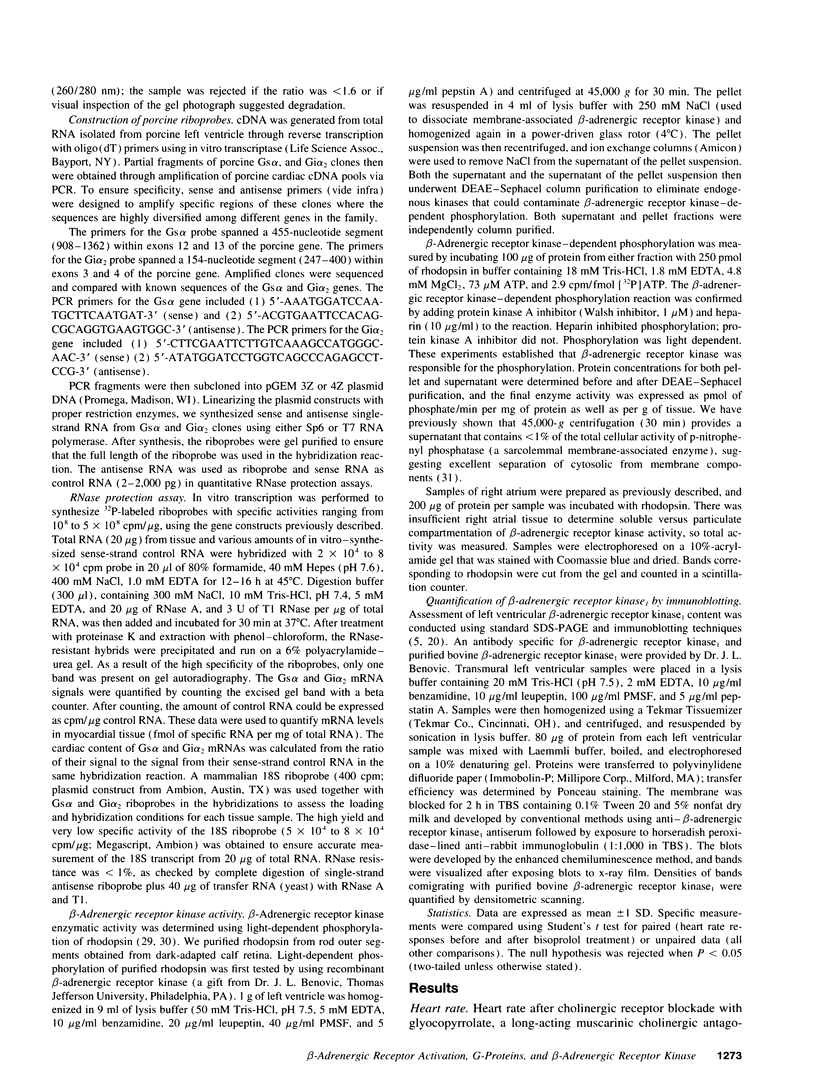
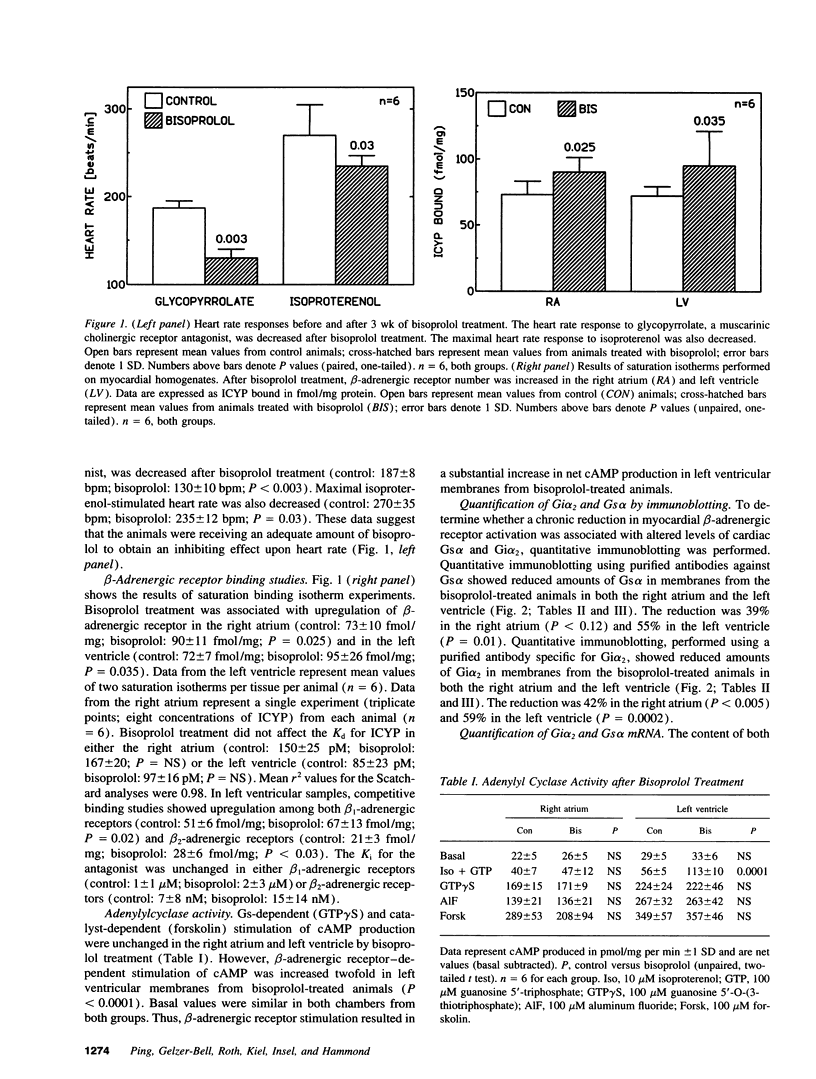
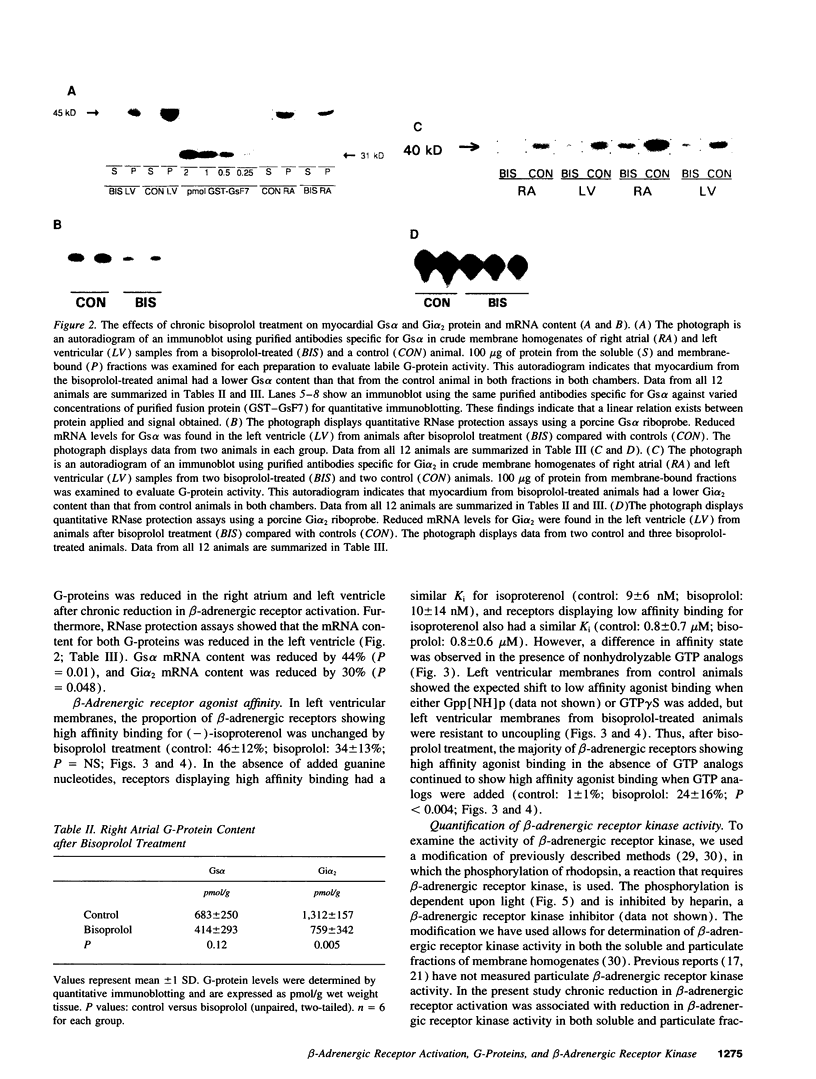
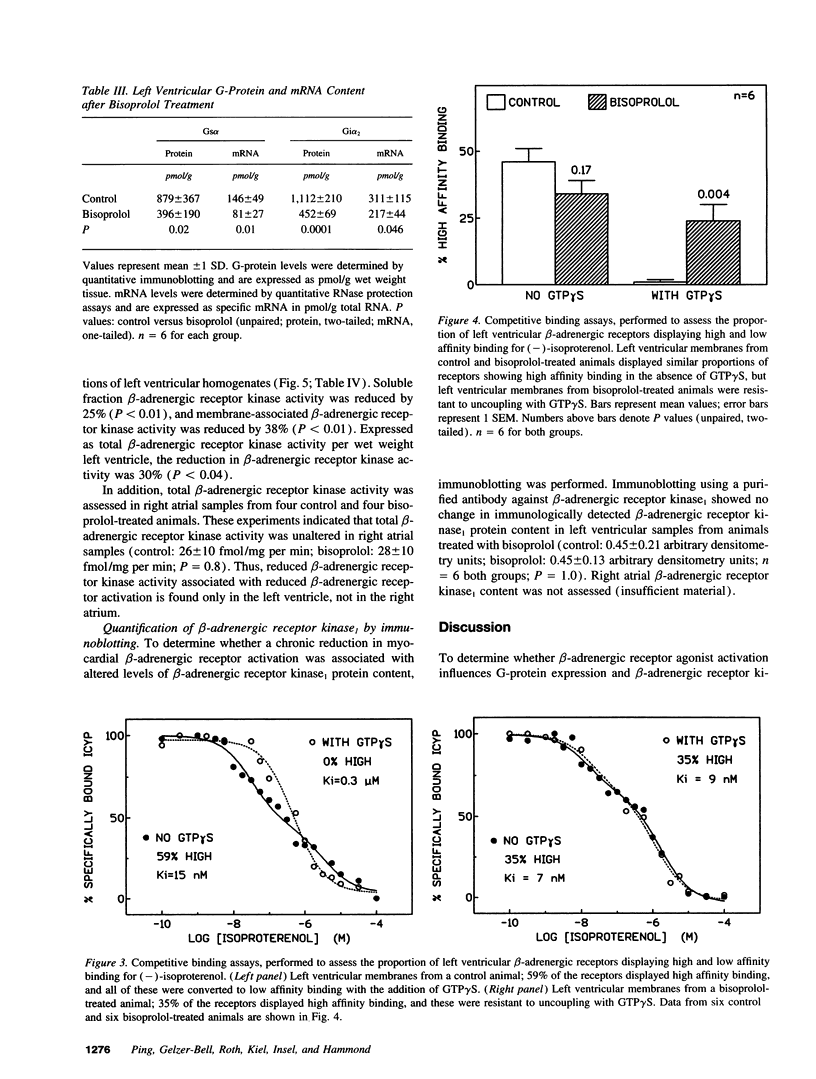
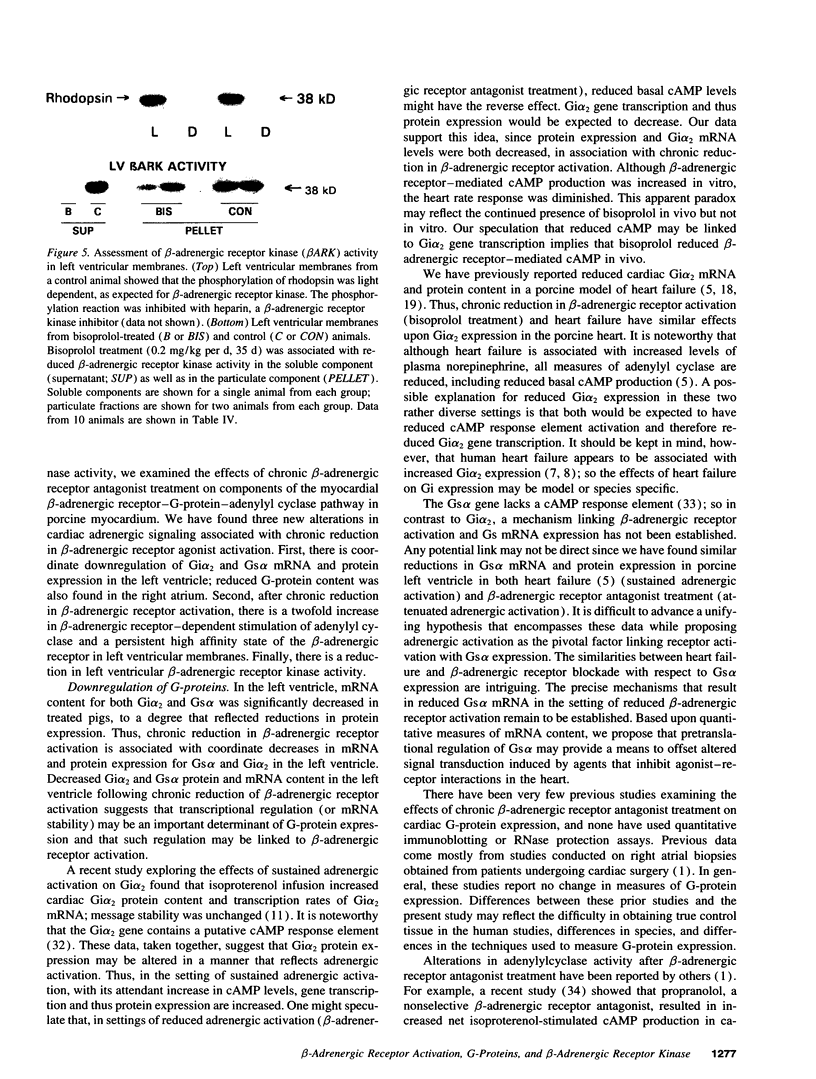
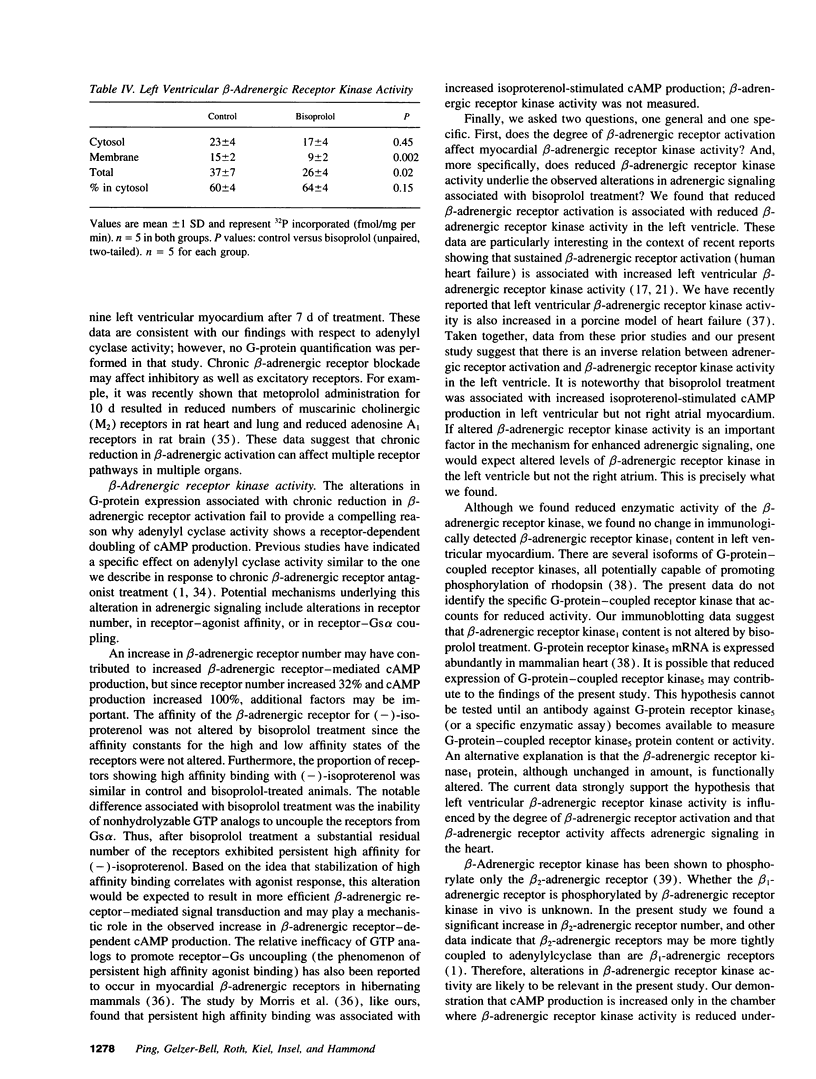
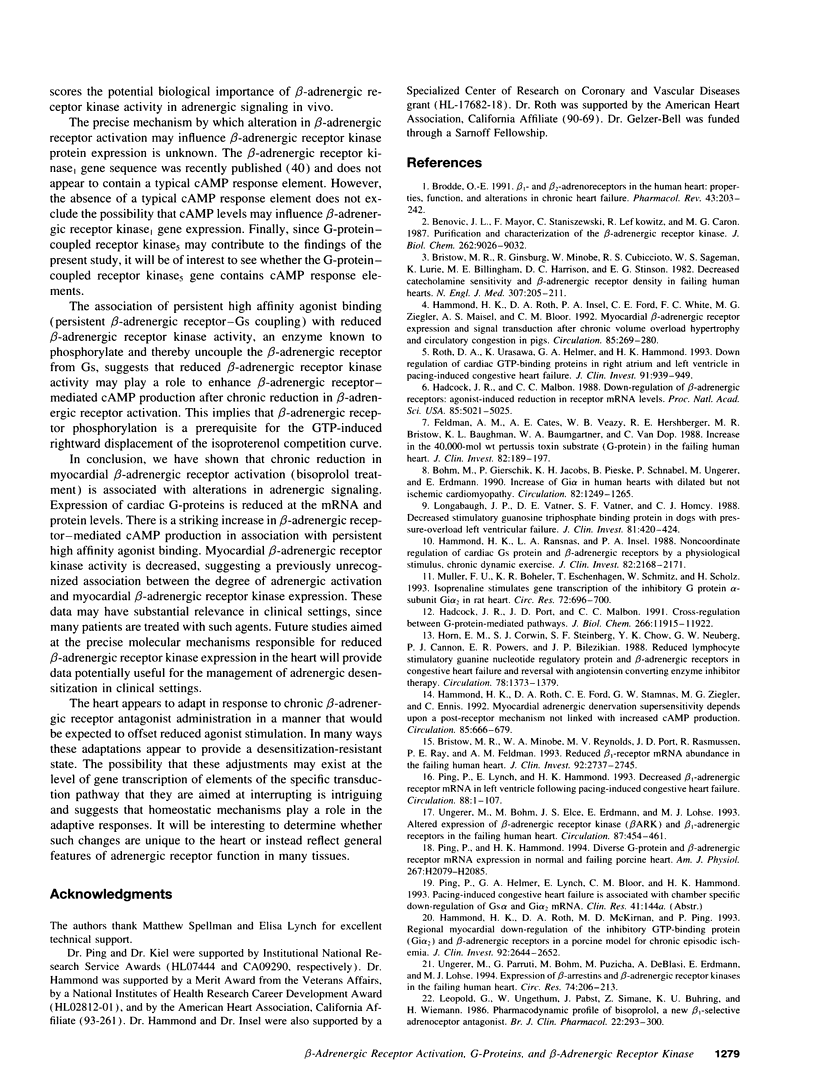
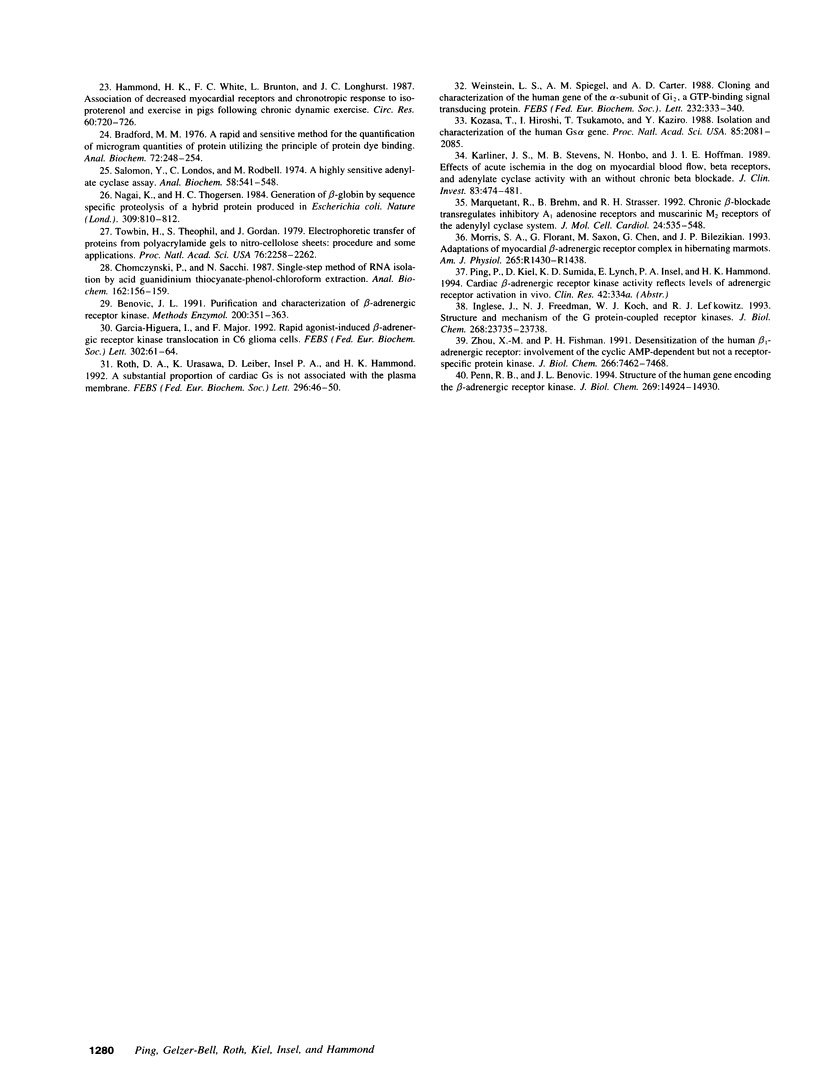
Images in this article
Selected References
These references are in PubMed. This may not be the complete list of references from this article.
- Benovic J. L., Mayor F., Jr, Staniszewski C., Lefkowitz R. J., Caron M. G. Purification and characterization of the beta-adrenergic receptor kinase. J Biol Chem. 1987 Jul 5;262(19):9026–9032. [PubMed] [Google Scholar]
- Benovic J. L. Purification and characterization of beta-adrenergic receptor kinase. Methods Enzymol. 1991;200:351–362. doi: 10.1016/0076-6879(91)00152-m. [DOI] [PubMed] [Google Scholar]
- Bradford M. M. A rapid and sensitive method for the quantitation of microgram quantities of protein utilizing the principle of protein-dye binding. Anal Biochem. 1976 May 7;72:248–254. doi: 10.1016/0003-2697(76)90527-3. [DOI] [PubMed] [Google Scholar]
- Bristow M. R., Ginsburg R., Minobe W., Cubicciotti R. S., Sageman W. S., Lurie K., Billingham M. E., Harrison D. C., Stinson E. B. Decreased catecholamine sensitivity and beta-adrenergic-receptor density in failing human hearts. N Engl J Med. 1982 Jul 22;307(4):205–211. doi: 10.1056/NEJM198207223070401. [DOI] [PubMed] [Google Scholar]
- Bristow M. R., Minobe W. A., Raynolds M. V., Port J. D., Rasmussen R., Ray P. E., Feldman A. M. Reduced beta 1 receptor messenger RNA abundance in the failing human heart. J Clin Invest. 1993 Dec;92(6):2737–2745. doi: 10.1172/JCI116891. [DOI] [PMC free article] [PubMed] [Google Scholar]
- Brodde O. E. Beta 1- and beta 2-adrenoceptors in the human heart: properties, function, and alterations in chronic heart failure. Pharmacol Rev. 1991 Jun;43(2):203–242. [PubMed] [Google Scholar]
- Böhm M., Gierschik P., Jakobs K. H., Pieske B., Schnabel P., Ungerer M., Erdmann E. Increase of Gi alpha in human hearts with dilated but not ischemic cardiomyopathy. Circulation. 1990 Oct;82(4):1249–1265. doi: 10.1161/01.cir.82.4.1249. [DOI] [PubMed] [Google Scholar]
- Chelm B. K., Hallick R. B., Gray P. W. Transcription program of the chloroplast genome of Euglena gracilis during chloroplast development. Proc Natl Acad Sci U S A. 1979 May;76(5):2258–2262. doi: 10.1073/pnas.76.5.2258. [DOI] [PMC free article] [PubMed] [Google Scholar]
- Chomczynski P., Sacchi N. Single-step method of RNA isolation by acid guanidinium thiocyanate-phenol-chloroform extraction. Anal Biochem. 1987 Apr;162(1):156–159. doi: 10.1006/abio.1987.9999. [DOI] [PubMed] [Google Scholar]
- Feldman A. M., Cates A. E., Veazey W. B., Hershberger R. E., Bristow M. R., Baughman K. L., Baumgartner W. A., Van Dop C. Increase of the 40,000-mol wt pertussis toxin substrate (G protein) in the failing human heart. J Clin Invest. 1988 Jul;82(1):189–197. doi: 10.1172/JCI113569. [DOI] [PMC free article] [PubMed] [Google Scholar]
- García-Higuera I., Mayor F., Jr Rapid agonist-induced beta-adrenergic receptor kinase translocation in C6 glioma cells. FEBS Lett. 1992 May 4;302(1):61–64. doi: 10.1016/0014-5793(92)80285-o. [DOI] [PubMed] [Google Scholar]
- Hadcock J. R., Malbon C. C. Down-regulation of beta-adrenergic receptors: agonist-induced reduction in receptor mRNA levels. Proc Natl Acad Sci U S A. 1988 Jul;85(14):5021–5025. doi: 10.1073/pnas.85.14.5021. [DOI] [PMC free article] [PubMed] [Google Scholar]
- Hadcock J. R., Port J. D., Malbon C. C. Cross-regulation between G-protein-mediated pathways. Activation of the inhibitory pathway of adenylylcylclase increases the expression of beta 2-adrenergic receptors. J Biol Chem. 1991 Jun 25;266(18):11915–11922. [PubMed] [Google Scholar]
- Hammond H. K., Ransnas L. A., Insel P. A. Noncoordinate regulation of cardiac Gs protein and beta-adrenergic receptors by a physiological stimulus, chronic dynamic exercise. J Clin Invest. 1988 Dec;82(6):2168–2171. doi: 10.1172/JCI113840. [DOI] [PMC free article] [PubMed] [Google Scholar]
- Hammond H. K., Roth D. A., Ford C. E., Stamnas G. W., Ziegler M. G., Ennis C. Myocardial adrenergic denervation supersensitivity depends on a postreceptor mechanism not linked with increased cAMP production. Circulation. 1992 Feb;85(2):666–679. doi: 10.1161/01.cir.85.2.666. [DOI] [PubMed] [Google Scholar]
- Hammond H. K., Roth D. A., Insel P. A., Ford C. E., White F. C., Maisel A. S., Ziegler M. G., Bloor C. M. Myocardial beta-adrenergic receptor expression and signal transduction after chronic volume-overload hypertrophy and circulatory congestion. Circulation. 1992 Jan;85(1):269–280. doi: 10.1161/01.cir.85.1.269. [DOI] [PubMed] [Google Scholar]
- Hammond H. K., Roth D. A., McKirnan M. D., Ping P. Regional myocardial downregulation of the inhibitory guanosine triphosphate-binding protein (Gi alpha 2) and beta-adrenergic receptors in a porcine model of chronic episodic myocardial ischemia. J Clin Invest. 1993 Dec;92(6):2644–2652. doi: 10.1172/JCI116880. [DOI] [PMC free article] [PubMed] [Google Scholar]
- Hammond H. K., White F. C., Brunton L. L., Longhurst J. C. Association of decreased myocardial beta-receptors and chronotropic response to isoproterenol and exercise in pigs following chronic dynamic exercise. Circ Res. 1987 May;60(5):720–726. doi: 10.1161/01.res.60.5.720. [DOI] [PubMed] [Google Scholar]
- Horn E. M., Corwin S. J., Steinberg S. F., Chow Y. K., Neuberg G. W., Cannon P. J., Powers E. R., Bilezikian J. P. Reduced lymphocyte stimulatory guanine nucleotide regulatory protein and beta-adrenergic receptors in congestive heart failure and reversal with angiotensin converting enzyme inhibitor therapy. Circulation. 1988 Dec;78(6):1373–1379. doi: 10.1161/01.cir.78.6.1373. [DOI] [PubMed] [Google Scholar]
- Inglese J., Freedman N. J., Koch W. J., Lefkowitz R. J. Structure and mechanism of the G protein-coupled receptor kinases. J Biol Chem. 1993 Nov 15;268(32):23735–23738. [PubMed] [Google Scholar]
- Karliner J. S., Stevens M. B., Honbo N., Hoffman J. I. Effects of acute ischemia in the dog on myocardial blood flow, beta receptors, and adenylate cyclase activity with and without chronic beta blockade. J Clin Invest. 1989 Feb;83(2):474–481. doi: 10.1172/JCI113906. [DOI] [PMC free article] [PubMed] [Google Scholar]
- Kozasa T., Itoh H., Tsukamoto T., Kaziro Y. Isolation and characterization of the human Gs alpha gene. Proc Natl Acad Sci U S A. 1988 Apr;85(7):2081–2085. doi: 10.1073/pnas.85.7.2081. [DOI] [PMC free article] [PubMed] [Google Scholar]
- Leopold G., Ungethüm W., Pabst J., Simane Z., Bühring K. U., Wiemann H. Pharmacodynamic profile of bisoprolol, a new beta 1-selective adrenoceptor antagonist. Br J Clin Pharmacol. 1986 Sep;22(3):293–300. doi: 10.1111/j.1365-2125.1986.tb02890.x. [DOI] [PMC free article] [PubMed] [Google Scholar]
- Longabaugh J. P., Vatner D. E., Vatner S. F., Homcy C. J. Decreased stimulatory guanosine triphosphate binding protein in dogs with pressure-overload left ventricular failure. J Clin Invest. 1988 Feb;81(2):420–424. doi: 10.1172/JCI113335. [DOI] [PMC free article] [PubMed] [Google Scholar]
- Marquetant R., Brehm B., Strasser R. H. Chronic beta-blockade transregulates inhibitory A1 adenosine and muscarinic M2 receptors of the adenylyl cyclase system. J Mol Cell Cardiol. 1992 May;24(5):535–548. doi: 10.1016/0022-2828(92)91842-s. [DOI] [PubMed] [Google Scholar]
- Morris S. A., Florant G., Saxon M., Chen G., Bilezikian J. P. Adaptations of myocardial beta-adrenergic receptor complex in hibernating marmots. Am J Physiol. 1993 Dec;265(6 Pt 2):R1430–R1438. doi: 10.1152/ajpregu.1993.265.6.R1430. [DOI] [PubMed] [Google Scholar]
- Müller F. U., Boheler K. R., Eschenhagen T., Schmitz W., Scholz H. Isoprenaline stimulates gene transcription of the inhibitory G protein alpha-subunit Gi alpha-2 in rat heart. Circ Res. 1993 Mar;72(3):696–700. doi: 10.1161/01.res.72.3.696. [DOI] [PubMed] [Google Scholar]
- Nagai K., Thøgersen H. C. Generation of beta-globin by sequence-specific proteolysis of a hybrid protein produced in Escherichia coli. 1984 Jun 28-Jul 4Nature. 309(5971):810–812. doi: 10.1038/309810a0. [DOI] [PubMed] [Google Scholar]
- Penn R. B., Benovic J. L. Structure of the human gene encoding the beta-adrenergic receptor kinase. J Biol Chem. 1994 May 27;269(21):14924–14930. [PubMed] [Google Scholar]
- Ping P., Hammond H. K. Diverse G protein and beta-adrenergic receptor mRNA expression in normal and failing porcine hearts. Am J Physiol. 1994 Nov;267(5 Pt 2):H2079–H2085. doi: 10.1152/ajpheart.1994.267.5.H2079. [DOI] [PubMed] [Google Scholar]
- Roth D. A., Urasawa K., Helmer G. A., Hammond H. K. Downregulation of cardiac guanosine 5'-triphosphate-binding proteins in right atrium and left ventricle in pacing-induced congestive heart failure. J Clin Invest. 1993 Mar;91(3):939–949. doi: 10.1172/JCI116315. [DOI] [PMC free article] [PubMed] [Google Scholar]
- Roth D. A., Urasawa K., Leiber D., Insel P. A., Hammond H. K. A substantial proportion of cardiac Gs is not associated with the plasma membrane. FEBS Lett. 1992 Jan 13;296(1):46–50. doi: 10.1016/0014-5793(92)80400-b. [DOI] [PubMed] [Google Scholar]
- Salomon Y., Londos C., Rodbell M. A highly sensitive adenylate cyclase assay. Anal Biochem. 1974 Apr;58(2):541–548. doi: 10.1016/0003-2697(74)90222-x. [DOI] [PubMed] [Google Scholar]
- Ungerer M., Böhm M., Elce J. S., Erdmann E., Lohse M. J. Altered expression of beta-adrenergic receptor kinase and beta 1-adrenergic receptors in the failing human heart. Circulation. 1993 Feb;87(2):454–463. doi: 10.1161/01.cir.87.2.454. [DOI] [PubMed] [Google Scholar]
- Ungerer M., Parruti G., Böhm M., Puzicha M., DeBlasi A., Erdmann E., Lohse M. J. Expression of beta-arrestins and beta-adrenergic receptor kinases in the failing human heart. Circ Res. 1994 Feb;74(2):206–213. doi: 10.1161/01.res.74.2.206. [DOI] [PubMed] [Google Scholar]
- Weinstein L. S., Spiegel A. M., Carter A. D. Cloning and characterization of the human gene for the alpha-subunit of Gi2, a GTP-binding signal transduction protein. FEBS Lett. 1988 May 23;232(2):333–340. doi: 10.1016/0014-5793(88)80764-6. [DOI] [PubMed] [Google Scholar]
- Zhou X. M., Fishman P. H. Desensitization of the human beta 1-adrenergic receptor. Involvement of the cyclic AMP-dependent but not a receptor-specific protein kinase. J Biol Chem. 1991 Apr 25;266(12):7462–7468. [PubMed] [Google Scholar]




